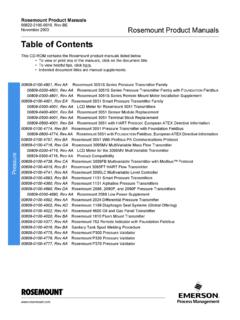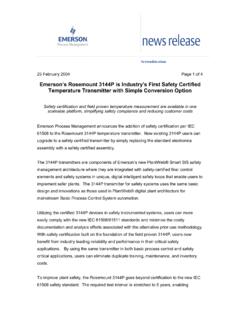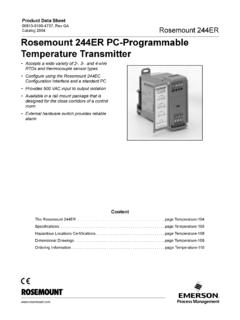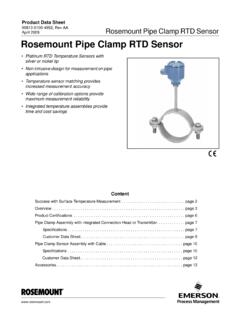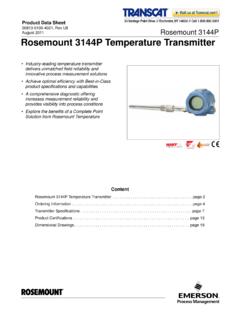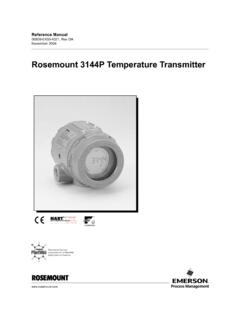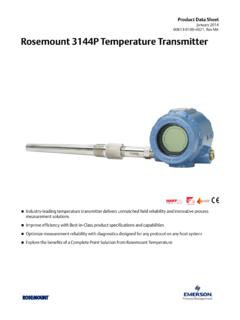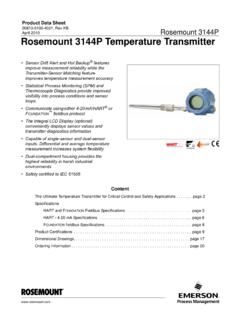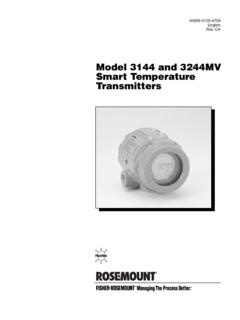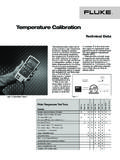Transcription of Model 3144P Smart Temperature Transmitter
1 Manual 00809-0100-4021, Rev BAApril 2003 Model 3144P Smart Temperature TransmitterReference Manual 00809-0100-4021, Rev BAApril 2003 Model 3144P Smart Temperature TransmitterModel 3144P Revision: Field Device Revision: Dev. v3, DD v2 rosemount Model 3144P Smart Temperature Transmitter may be protected by one or more Patents Pending. Other foreign patents this manual before working with the product. For personal and system safety, and for optimum product performance, make sure you thoroughly understand the contents before installing, using, or maintaining this the United States, rosemount Inc. has two toll-free assistance numbers:Customer CentralTechnical support, quoting, and order-related (7:00 am to 7:00 pm CST)North American Response CenterEquipment service (24 hours)International(952)-906-8888 The products described in this document are NOT designed for nuclear-qualified applications. Using non-nuclear qualified products in applications that require nuclear-qualified hardware or products may cause inaccurate information on rosemount nuclear-qualified products, contact your local Emerson Process Management Sales Manual 00809-0100-4021, Rev BAApril 2003 Model of ContentsSECTION 1 IntroductionOverview.
2 1-1 Manual .. 1-1 Transmitter .. 1-1 Considerations.. 1-1 General .. 1-1 Electrical .. 1-2 Environmental.. 1-2 Mounting.. 1-3 Software Compatibility .. 1-3 Model 3144P and Models 3144 / 3244MV Differences .. 1-4 SECTION 2 InstallationSafety Messages .. 2-1 Warnings .. 2-1 Commissioning .. 2-2 Setting the Loop to Manual.. 2-2 Set the Switches .. 2-3 Mounting .. 2-4 Installation .. 2-5 Typical North American Installation .. 2-5 Typical European Installation .. 2-6In Conjunction with a Model 333 HART Tri-Loop .. 2-7 LCD Meter .. 2-8 Multichannel Installations .. 2-9 Wiring.. 2-9 Field Wiring.. 2-9 Sensor Connections .. 2-10 Power/Current Loop Connections .. 2-11 Power Supply.. 2-12 Surges/Transients .. 2-12 Grounding.. 2-13 SECTION 3 CommissioningOverview .. 3-1 Safety Messages .. 3-1 Warnings .. 3-1 Model 275 HART Communicator.. 3-2 Updating the Model 275 HART Communication Software .. 3-2 Menu Tree .. 3-3 Fast Key Sequences.
3 3-4 AMS .. 3-5 Apply AMS Changes .. 3-5 Review Configuration Data .. 3-5 Check Output.. 3-6 Configuration .. 3-6 Reference Manual00809-0100-4021, Rev BAApril 2003 Model 3144 PTOC-2 Device Output Configuration .. 3-14 Device Information.. 3-18 Measurement Filtering .. 3-19 Diagnostics and Service .. 3-21 Multidrop Communication .. 3-23 Use with the HART Tri-Loop .. 3-24 SECTION 4 Operation and MaintenanceSafety Messages .. 4-1 Warning .. 4-1 Calibration .. 4-2 Trim the Transmitter .. 4-2 Hardware .. 4-9 Diagnostics with HART Communicator .. 4-9 Diagnostics with AMS .. 4-10 Maintenance .. 4-12 Assembling the Electronics Housing .. 4-13 Replacing the Electronics Module .. 4-13 LCD Meter Diagnostic Messages .. 4-13 AMS Screens Diagnostic Messages .. 4-16 Model 275 HART Communicator.. 4-17 Diagnostic Messages .. 4-17 AMS Software .. 4-20 Diagnostic Messages .. 4-20 AMS Variables .. 4-20 APPENDIX ASpecifications and Reference DataSpecifications.
4 A-1 Functional .. A-1 Physical .. A-3 Performance .. A-4 Dimensional Drawings .. A-7 Ordering Information .. A-9 Transmitter .. A-9 Spare Parts List .. A-10 Tagging .. A-10 Hardware .. A-10 Software Tag .. A-10 External Ground Screw Assembly .. A-11 Configuration .. A-11 Standard .. A-11 Custom .. A-11 APPENDIX BProduct CertificationsHazardous Locations Installations .. B-1 North American Approvals .. B-1 European Approvals .. B-2 Australian Approvals.. B-3 Japanese Approval.. B-4 Brazilian Approval.. B-4 Combination Approval .. B-4 Additional Approvals .. B-4 Installation Drawings .. B-5 Reference Manual 00809-0100-4021, Rev BAApril 2003 TOC-3 Model 3144 PAPPENDIX CSafety Instrumented System (SIS)Overview ..C-1 Failure Rate Data..C-2 Model 3144P with and without a RTD ..C-2 Model 3144P with and without a Thermocouple..C-2 Installation ..C-3 Switches ..C-3 Changing Switch Position..C-3 Reference Manual00809-0100-4021, Rev BAApril 2003 Model 3144 PTOC-4 Reference Manual 00809-0100-4021, Rev BAApril 2003 Model 1 IntroductionOverview.
5 Page 1-1 Considerations .. page 1-1 Model 3144P and Models 3144 / 3244MV Differences .. page 1-4 OVERVIEWM anualThis manual is intended to assist in the installation, operation, and maintenance of the rosemount Model 3144P Smart Temperature Transmitter . Section 1: IntroductionSection 2: InstallationSection 3: CommissioningSection 4: Operation and MaintenanceAppendix A: Specifications and Reference DataAppendix B: Hazardous Area ApprovalsAppendix C: Safety Instrumented System (SIS)TransmitterThe rosemount Model 3144P Smart Temperature Transmitter is a microprocessor-based instrument that accepts input from a wide variety of sensors and transmits Temperature data to a control system or Transmitter interface. The Transmitter combines Emerson Process Management reliability with the flexibility of digital electronics. The Transmitter is ideal for applications that require high performance and/or remote AMS software and Model 275 HART Communicator use HART protocol to interrogate, configure, test, and format the Model 3144P Transmitter .
6 Communication can be made with the Transmitter from the control room, Transmitter site, or across any other two points in the loop provided the loop contains 250 to 1100 ohms of resistance. Special dual-sensor features include Hot Backup , sensor drift alert, first good, differential and average Temperature measurements, and four simultaneous measurement variable outputs in addition to the analog output signalCONSIDERATIONSG eneralElectrical Temperature sensors, such as resistance Temperature detectors (RTDs) and thermocouples (T/Cs), produce low-level signals proportional to Temperature . The Model 3144P Transmitter converts low-level sensor signals to a standard 4 20 mA dc signal. This current signal is then transmitted to the control room via two power/signal Manual00809-0100-4021, Rev BAApril 2003 Model 3144P1-2 Electrical Proper electrical installation is essential to prevent errors due to sensor lead resistance and electrical noise.
7 Shielded cable should be used for best results in electrically noisy environments. The current loop must have between 250 and 1100 ohms resistance for HART communications. Refer to Figure 2-10 on page 2-11 for sensor and current loop Temperature EffectsThe Transmitter will operate within specifications for ambient temperatures between 40 and 185 F ( 40 and 85 C). Heat from the process is transferred from the thermowell to the Transmitter housing. If the expected process Temperature is near or beyond specification limits, consider the use of additional thermowell lagging, an extension nipple, or a remote mounting configuration to isolate the Transmitter from the process. Figure 1-1 describes the relationship between housing Temperature rise and extension 1-1. Model 3144P Transmitter Housing Temperature Rise versus Extension Length for a Test : The maximum permissible housing Temperature rise (T) can be calculated by subtracting the maximum ambient Temperature (A) from the Transmitter s ambient Temperature specification limit (S).
8 For instance, suppose A = 40 = S - AT = 85 C 40 CT = 45 CFor a process Temperature of 540 C (1004 F), an extension length of inches ( mm) yields a housing Temperature rise (R) of 22 C (72 F), which provides a safety margin of 23 C (73 F). A six-inch extension length (R = 10 C (50 F)) would offer a higher safety margin (35 C (95 F)) and would reduce Temperature -effect errors but would probably require extra Transmitter support. Gauge the requirements for individual applications along this scale. If a thermowell with lagging is used, the extension length may be reduced by the length of the Temperature Rise, Above Ambient C ( F)3456789060 (108)50 (90)40 (72)30 (54)20 (36)10 (18) Length (in.)3044-0123A815 C (1500 F) Oven Temperature540 C (1000 F) Oven Temperature250 C (482 F) Oven TemperatureReference Manual00809-0100-4021, Rev BAApril 2003 Model 3144P1-3 Moist or Corrosive EnvironmentsThe Model 3144P Temperature Transmitter has a highly reliable dual compartment housing designed to resist moisture and corrosion.
9 The sealed electronics module is mounted in a compartment that is isolated from the terminal side conduit entries. O-ring seals protect the interior when the covers are properly installed. In humid environments, however, it is possible for moisture to accumulate in conduit lines and drain into the Transmitter is clearly marked with a tag indicating the approvals. Install the Transmitter in accordance with all applicable installation codes and approval and installation drawings (see Appendix B: Product Certifications). Verify that the operating atmosphere of the Transmitter is consistent with the hazardous locations certifications. Once a device labeled with multiple approval types is installed, it should not be reinstalled using any of the other labeled approval types. To ensure this, the approval label should be permanently marked to distinguish the used from the unused approval type(s).Mounting Take into account the need for access to the Transmitter when choosing an installation location and Side of Electronics HousingMount the Transmitter so the terminal side is accessible.
10 Allow adequate clearance for cover removal. Make wiring connections through the conduit openings on the bottom of the Side of Electronics HousingMount the Transmitter so the circuit side is accessible. Provide adequate clearance for cover removal. Additional room is required for LCD installation. The Transmitter may be mounted directly to or remotely from the sensor. Using optional mounting brackets, the Transmitter may be mounted to a flat surface or to a two-inch diameter pipe (see Optional Transmitter Mounting Brackets on page A-8).Software CompatibilityReplacement transmitters may contain revised software that is not fully compatible with the existing software in your HART 275 HART Communicators and AMS software containing device descriptors for the Models 3144 and 3244MV before December 2001 do not fully support the new features of the Model 3144P . The HART Communicator Field Device Revisions Dev v3,DD v2 should be loaded into the Model 275 HART Communicator to communicate with the new features of the Model 3144P .
